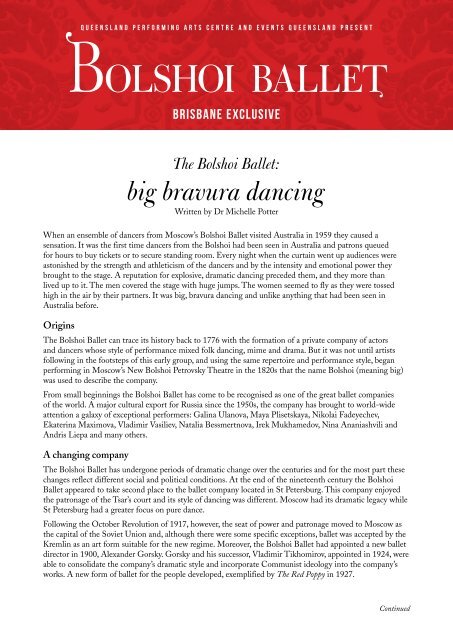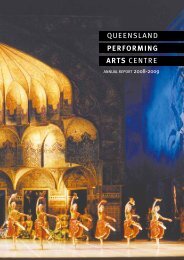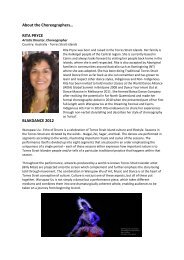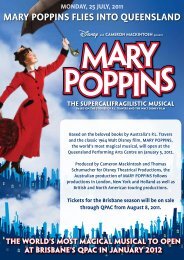Download - QPAC
Download - QPAC
Download - QPAC
You also want an ePaper? Increase the reach of your titles
YUMPU automatically turns print PDFs into web optimized ePapers that Google loves.
QUEENSLAND PERFORMING ARTS CENTRE AND EVENTS QUEENSLAND PRESENT<br />
BRISBANE EXCLUSIVE<br />
The Bolshoi Ballet:<br />
big bravura dancing<br />
Written by Dr Michelle Potter<br />
When an ensemble of dancers from Moscow’s Bolshoi Ballet visited Australia in 1959 they caused a<br />
sensation. It was the first time dancers from the Bolshoi had been seen in Australia and patrons queued<br />
for hours to buy tickets or to secure standing room. Every night when the curtain went up audiences were<br />
astonished by the strength and athleticism of the dancers and by the intensity and emotional power they<br />
brought to the stage. A reputation for explosive, dramatic dancing preceded them, and they more than<br />
lived up to it. The men covered the stage with huge jumps. The women seemed to fly as they were tossed<br />
high in the air by their partners. It was big, bravura dancing and unlike anything that had been seen in<br />
Australia before.<br />
Origins<br />
The Bolshoi Ballet can trace its history back to 1776 with the formation of a private company of actors<br />
and dancers whose style of performance mixed folk dancing, mime and drama. But it was not until artists<br />
following in the footsteps of this early group, and using the same repertoire and performance style, began<br />
performing in Moscow’s New Bolshoi Petrovsky Theatre in the 1820s that the name Bolshoi (meaning big)<br />
was used to describe the company.<br />
From small beginnings the Bolshoi Ballet has come to be recognised as one of the great ballet companies<br />
of the world. A major cultural export for Russia since the 1950s, the company has brought to world-wide<br />
attention a galaxy of exceptional performers: Galina Ulanova, Maya Plisetskaya, Nikolai Fadeyechev,<br />
Ekaterina Maximova, Vladimir Va siliev, Natalia Bessmertnova, Irek Mukhamedov, Nina Ananiashvili and<br />
Andris Liepa and many others.<br />
A changing company<br />
The Bolshoi Ballet has undergone periods of dramatic change over the centuries and for the most part these<br />
changes reflect different social and political conditions. At the end of the nineteenth century the Bolshoi<br />
Ballet appeared to take second place to the ballet company located in St Petersburg. This company enjoyed<br />
the patronage of the Tsar’s court and its style of dancing was different. Moscow had its dramatic legacy while<br />
St Petersburg had a greater focus on pure dance.<br />
Following the October Revolution of 1917, however, the seat of power and patronage moved to Moscow as<br />
the capital of the Soviet Union and, although there were some specific exceptions, ballet was accepted by the<br />
Kremlin as an art form suitable for the new regime. Moreover, the Bolshoi Ballet had appointed a new ballet<br />
director in 1900, Alexander Gorsky. Gorsky and his successor, Vladimir Tikhomirov, appointed in 1924, were<br />
able to consolidate the company’s dramatic style and incorporate Communist ideology into the company’s<br />
works. A new form of ballet for the people developed, exemplified by The Red Poppy in 1927.<br />
Continued
















